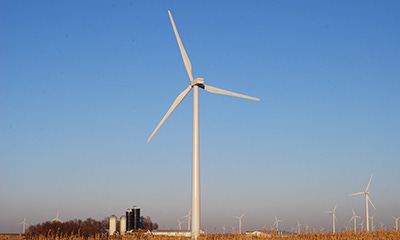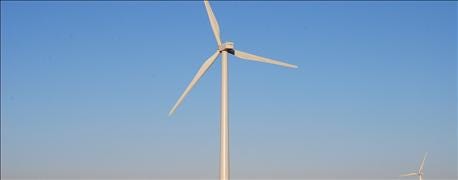
Over 31% of Iowa’s electricity is now supplied by wind. Gov. Terry Branstad made the announcement earlier this week. He cited new data released by the U.S. Energy Information Administration, showing Iowa is the first and only state in the nation that has crossed the 30% mark. Iowa is followed by South Dakota, Kansas, Oklahoma and North Dakota.
Related: What's a wind turbine lease worth?

WINDPOWER: Over 31% of Iowa’s electricity is now supplied by wind turbines. State and national officials say the state has the potential to climb above 40% in the next 5 years. Iowa leads the nation in percentage of electricity generated from wind.
“We are proud of Iowa’s leadership in wind energy,” says Branstad, chairman of the Governor’s Wind and Solar Energy Coalition. “We’ve seen exponential growth in wind energy and the data released last week reinforces what we’ve been seeing in every corner of our state. With potential to jump above 40% in the next five years, we are committed to building an even greener Iowa future that will provide our Iowa families with cleaner, renewable energy and job opportunities.”
Iowa is committed to having clean, renewable, reliable wind energy
The growing number of wind farms in Iowa has attracted $11.8 billion dollars to the state’s economy, according to data released by the American Wind Energy Association (AWEA) last week. Wind can supply 40% of the Hawkeye State’s in-state electricity generation within the next five years – generating enough electricity for 6.3 million average American homes – according to a report by AWEA that uses U.S. Department of Energy data.
Lt. Gov. Kim Reynolds adds, “As chair of the Iowa Energy Plan, I’ve heard firsthand from existing and prospective companies how important it is to have clean, renewable and reliable sources of energy like wind. The data released last week shows how committed Iowa is to promoting an environment for companies to grow and innovate. But we are not done yet and believe that Iowa is on the forefront of an even greater renewable future for our state.”
Wind energy helps keep air clean and cuts costs for consumers
“Iowa is blessed with world-class wind resources,” says Tom Kiernan, CEO of the American Wind Energy Association. “We’re tapping into this homegrown resource more than ever thanks to American innovation and U.S. workers building the most productive wind turbines in the world. More than ever, low-cost wind energy is keeping our air clean and cutting costs for consumers. American wind power is well on its way to supplying 20% of U.S. electricity by 2030.”

Even though photovoltaic solar energy is a small percentage of Iowa’s total electricity generation, the use of solar has also climbed in Iowa. Last year it reached 71% higher than the amount of solar energy used in 2015, the new report showed.
Renewable energy efforts have received a boost from state and federal tax credits that encourage adoption of solar and wind energy in Iowa. Last year, Congress agreed to extend the incentives. Over the past decade, Iowa has attracted $11.8 billion in investment to build windfarms, according to the American Wind Energy Association.
We need clean, renewable, reliable sources of energy—like wind
Mid-American Energy, based in Des Moines, is a good example. It has invested heavily in building wind energy turbines and capacity, about $6 billion since 2004. The company expects to generate about 57% of its electricity from wind by 2017.
Wind energy, according to the Wind Energy Association, has created about 6,000 jobs in Iowa, including positions at 13 factories that build wind turbine parts and materials. The association says wind developers pay Iowa farmers and other rural landowners about $17.1 million annually to place the turbines on their land.

The association says wind energy helps keep electricity rates low. It projects that growth in Iowa’s wind industry will help provide $3.6 billion in savings for ratepayers through 2050. The association also says wind energy is helping to improve air quality. Last year, for example, was the lowest yearly carbon emissions produced by the U.S. power sector since 1995, in part because of renewable energy, industry sources.
About the Author(s)
You May Also Like




